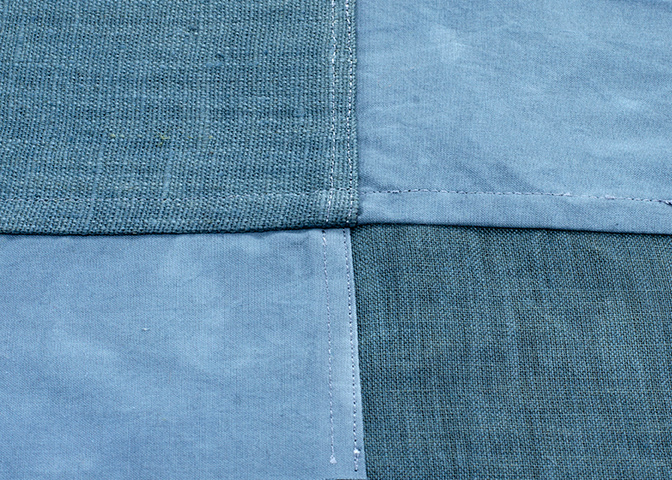The Research and Development Project explores Korean Pojagi patchwork. Using natural raw cotton and linen fabrics, Alexandra Holt has created reversible patchworks, embellished with digital embroidery inspired by the shapes and marks found in the designers collection of still life drawings. The colour palette embraces the natural shades of the fabrics and draws on colours that can be found in nature. The fabrics are dyed to recreate the shades found in traditional indigo dyeing. This research will be developed through to FMP, in which the designer will explore natural indigo dyeing. The embroidery, produced using madeira metallic and polyester thread, is inspired by traditional Korean embroidery on royal Pojagi's. The aim for this project is to create wearable pieces of art which celebrate a form of patchwork that is lesser known in the West.

This sample started me off on my Pojagi journey. I used the modern pojagi method to create this machine sewn patchwork and then i applied small, delicate embroidery using marks taken from my drawings.

Here is a close up of the embroidery seen in the previous photo. There is a combination of walking stitches and complex filled shapes.

To mix up how the embroidery is applied, I tried applying digital embroidery first to separate pieces of each fabric, which are then sewn together using the modern Pojagi technique which can be done on a sewing machine.

As seen in this close up image certain fabrics such as the thicker linen did not take the embroidery easily. The silk was also difficult to apply embroidery to evenly.

I began to explore different scales, testing how the machine would create very small embroidery and how it would affect the ground fabric.

Here is a close up of a small embroidery piece on cotton fabric.

Hand sewn Pojagi sample using natural dyed cotton thread dyed with turmeric

This sample was my first attempt at hand sewing a Pojagi seam. I constructed the patchwork using natural, unfinished linen and cotton fabrics with white polyester thread. After I created the patchwork I placed it into a synthetic indigo dye bath. The thread remained white as it did not absorb the dye, leaving really interesting marks.

I have been practicing my precision and skill to make my patchworks as beautiful as possible.

A close up of my precision sample.

Further testing of how embroidery scale affects the precision of the outcome and how the ground fabric behaves.

This close up shows that the machine struggled to finish the walking stitches in the central motif. The scale would need to be increased on this fabric.

This sample was embroidered onto first, then dyed. It is at a larger scale so a larger surface area can be blocked from the dye.

This is a close up of the embroidery created which will hopefully leave faint impressions underneath.

I used a 22inch hoop to digitally stitch a design onto.

Pre-dyed natural fabrics machine sewn using the modern Pojagi method. Inspiration for the mark making shapes were taken from my drawings.

This close up shows the detail and intricacy of the design and the different scales that are used.

In this sample I took a regular triangle pattern and repeated it along a piece of silk fabric. The sample was dyed after being embroidered to see how it would affect the embroidery.

This sample was originally intended to be unpicked, where paler marks would be left underneath. I soon realised that the marks were too small and thin to block any of the dye effectively so I chose to leave the embroidery as it was. The shade of the ground fabric really accentuates the colours of the embroidery.

As I begin to explore creating larger patchworks which can be turned into hanging textile art pieces or Kimono's, I explored more extreme scales and use of space. This embroidery design was created with the idea the marks would flow and swoop across the patchwork ground.


